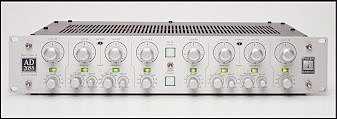
|
REVIEWS: From Audio Media |
|
AVALON DESIGN AD2055 Produced by American company Avalon Design, the AD2055 is a Pure Class A parametric equaliser. ZENON SCHOEPE puts it through its paces. DUAL MONO PARAMETRIC EQUALISER How do you begin to evaluate a dual-channel EQ that asks in excess of £3,500? Normally you start by clocking features that you would expect to find on units costing considerably less – do this on the Avalon AD2055 and you head for disappointment. There is no form of input or output metering or gain make up pots, those who expect a heavy duty EQ to offer sweepable high and low-pass filters will find them lacking as are fully parametric bands. Maybe you would also expect a couple of commensurate quality mic preamps – there are none. 
What you get for the price of the second family car is something a little different. The 2055 uses fully discrete pure Class A signal amplifiers with passive and active filters, and fully balanced DC coupled high current Class A line drivers for its connectors. Every amplifier in the unit uses 16 Watts' worth of output drivers, and there are about 40 amplifiers in total. Sporting +30dB of headroom, -92dB of noise (EQ in 20kHz unweighted), and a bandwidth within -3dB from 1Hz to 600kHz, it is a beast, and it is aimed at the golden ear end of audiophile pro audio users. Avalon is a small American company, started by designer Wynton Morro in 1986, dedicated to pushing the edge in solid- state electronics. It also makes an opto compressor (no VCA), electronic crossovers, preamps, and is currently working on a large frame recording console, based on the same electronic principles, which promises to be frightening and very competitively priced according to Morro. The 2055 is a no-holds-barred equaliser majoring on all the musicality that discrete circuitry is tamed for. It is expensive because among other reasons, the fully discrete 80V Class A amplifiers used cost about 20 times the price of the plug-in ICs other manufacturers use. If it makes anybody feel any better about the 2055, I am reassured by its designer that it is still difficult to manufacture at this price and that it is as competitively priced as can be. Despite the price, some 75 units have been sold since the unit became available seven months ago. This 2U rack-mount unit, with large smooth knobs and illuminated switches, offers two channels of four bands. The ten frequency, passive HF and LF sections are switchable for shelf or peak, using a large array of switched capacitors and two active fully variable, mid bands with x10 multiplier switches and fully variable Qs. Individual channel bypasses are activated by sealed silver plated relays. Power comes up through a compact external power supply. The first thing you notice when drooling over the 2055 is that not all bands offer the same boost/cut ranges. The mids give ±16dB, the HF ±20dB, and surprisingly the LF ±24dB. In use and on listening, this provides extremely well balanced four bands that have an immediate and very satisfying pot turn/aural result response. Tons of equalisation is available, all of which seems to be precisely where you want it. You can whack up any band frequency almost blindfold and quickly convince yourself that it is what you wanted and that it sounds better than the original. It is just that sort of flattering super-smooth box. Fine control in the mid bands is awesome and so simple to administer correctively. Everybody knows how to tune out an offending frequency, but in the practice, this can be tricky with many types of equaliser, because you often have to make do with a setting that least upsets the remainder of the programme, rather than one that best removes what you don't want. The 2055 gives the impression of superimposing its programmed spectral curve on top of the original programme leaving the bed rock signal intact. Spectacular stuff. In Use I particularly like the passive HF and LF. In fact, I found it hard to leave these out of circuit, so smooth and obvious are the merest turns of lift or cut. The LF provides the tightest yet most immense bottom end that I have ever heard. It is simply unflappable. Not only can you get clean and tidy whoomph out of just about anything, you can also develop low-end response that you didn't know your speakers had. The top end is crystal clear and somehow better able to dodge around the hiss band and boost creatively. The beauty of the arrangement is that you can combine or compare passive and active results in the overlapping regions of adjacent bands with markedly different yet equally pleasant results. Perhaps the most impressive aspect is that you can get tones out of this box in the same way that you can get tones out of an instrument. It is quite incredibly creative. Cascading channels and really getting some musical amplitude going in the signal will not provoke a single squeak out of the Avalon. No matter how hard you crank it, it remains smooth and unflustered. There is an obscene amount of headroom – the limitation will be what you connect to either end. Conclusion This is an extraordinarily fine equaliser, that is supremely sweet. Whether it is worth in excess of £3,500 is a question that can only be answered by those who have this sort of loose cash to spend on a dual-channel EQ, and by definition, that's not going to be many of us. It's not for ordinary folk, this is EQ for the gods. Hear it and weep. Back to Reviews Index & User List |
Tel: +1 949 492
2000
©2023 Avalon Design USA LLC